Passive cooling relies on numerous seemingly insignificant measures that, when combined, dramatically reduce cooling loads in a building. Home designers group these measures in four general categories: (1) reducing internal heat gain (2) reducing external heat gain, (3) purging built-up heat, and (4) cooling people directly. Let’s take a look at each one and explore the strategies at our disposal.
FYI: Power outages can be costly, according to the Arthur D. Little Company. They can cost brokerage operations nearly $6.5 million an hour. They can cost credit card companies over $2.5 million per hour and airlines $90,000 per hour in lost reservations.
FYI: Passive cooling taps into natural forces, such as cool breezes, shade, and cool nighttime air, and ordinary building components, such as insulation, overhangs, and energy-efficient windows, to cool homes.
Reducing Internal Heat Gain
All homes contain numerous sources of heat within their walls. These, in turn, result in a phenomenon called internal heat gain. Common sources of internal heat gain include people, pets, electronic devices, and lights, which all generate varying amounts of heat. Even small transformers for answering machines produce a small amount of waste heat. The most significant sources of heat include conventional stoves and ovens, clothes dryers, dishwashers, water heaters, conventional incandescent lights, aquarium lights and heaters, television sets, and computers. Even microwave ovens produce waste heat, though much less than conventional stoves and ovens,
When added up, these numerous small and seemingly insignificant internal heat sources collectively generate a substantial amount of heat, In the winter, internal heat sources help keep buildings warmer; in fact, in some super smart, energy-efficient office buildings, internal heat sources from copy machines, computers, lights, people, and other sources satisfy much of the wintertime heat load. At times internal heat sources are an asset.
In the summer, however, internal heat sources become a liability; they make our homes and offices warmer and less comfort able, and they contribute to higher fuel bills. Although ridding a home of internal heat sources could increase heating costs, cooling costs generally outweigh heating costs. It makes economic sense in the long run to eliminate internal heat sources.
Eliminating internal heat gain is the first step to passively cooling your home. I recommend that you start by systematically locating all sources of internal heat gain in your home. To begin, take out a piece of paper and make a list of all appliances, electronic devices, and lights in your home, Which ones are used most frequently Star those items and focus your attention on them.
FYI: When You’re Hot, You’re Hot! An adult produces as much heat as a 50 to 70-watt light bulb, depending on his/her age, metabolic rate, and physical activity.
With this list completed, your next task is to jot down a strategy or two for reducing or eliminating the heat generated by each item on your list, For example, next to the most commonly used incandescent lights you could write “replace with compact fluorescent light bulbs,” Next to the stove and oven, you can write “use the microwave during the summer more than the stove;’ as microwaves produce much less heat to do the same job. You could also consider cooking more meals outdoors on a grill or a solar oven. Or, you could eat meals that require less cook time, for example, salads with chicken or boiled eggs for protein. Next to the water heater, write “install an insulated water heater blanket. Next to the clothes dryer, you could write “hang clothes on outside line: As you work through the list, you will find that most heat-reducing solutions are fairly easy and inexpensive. Bear in mind, how ever, that some of the more costly responses make sense over the long term, for example, replacing an old, inefficient water heater with an on-demand model, especially a model without a pilot light (Section 2). More costly solutions such as this often make good sense, especially if the appliance needs replacement anyway.
The table below lists major heat producers in a typical North American home and ways to reduce their contribution to internal heat gain — both inexpensive options and more costly ones.
Reducing External Heat Gain
Strategies to reduce internal heat gain are, for the most part, relatively painless and economical. Unfortunately, the most significant source of heat in most homes during the summer is external heat gain — heat that enters your home from the outside.
FYI: The most significant source of heat in most homes during the summer is external heat gain — heat entering a home from the outside.
Heat enters our homes in a variety of ways. For instance, light striking the roof of a house is absorbed by the shingles and converted to heat (see ___ below). Much of this heat is conducted through the roof into the attic. It then passes through the insulation or, more likely, through the wood framing of the ceiling and radiates into our homes. (Attics are typically 30 to 40°F [17° to 22°C] hotter than ambient air.) In homes built without attics, heat passes directly from the roof through the ceiling cavity into the living space.
Sunlight striking windows and walls also heats up our homes, as shown in below figure. But that’s not all. Warm air surrounding our homes also contributes to external heat gain. Warm air is generated when sunlight strikes driveways, streets, sidewalks, patios, and decks. Warm air surrounding our homes heats up the walls and windows, much the same way a pie is heated in an oven, External heat is then conducted through walls into our homes. Warm air can also enter our homes through open doors and windows and through cracks in the building envelope, as explained in an earlier section of this guide.
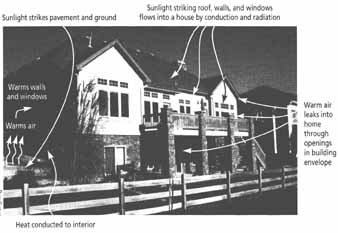
This image of a typical house shows all of the potential
sources of external heat gain. Sunlight strikes pavement and ground.
Sunlight striking roof, walls, and windows flows into a house by conduction and radiation; Warm air leaks into home through openings in building envelope;
Heat conducted to interior.
REDUCING INTERNAL HEAT GAIN:
Heat Source |
Contribution to Internal Heat Gain |
Cheap Option |
Costly Option |
Incandescent lights |
Major |
Use lights more sparingly. Turn lights off when not in use. Unscrew light bulbs in areas where they are not needed. |
Replace with compact fluorescents. Install occupancy sensors that switch lights off when rooms are unoccupied. |
Water heater |
Major |
Turn temperature down to 120°F (49°C). Install insulation: water heater blanket. Insulate hot water pipes. |
Replace old models with on-demand (tankless) water heaters. |
Stove and oven |
Major |
Eat more cold meals during the summer. Cook outside as much as possible. Use the microwave more during the summer. Bake at night. Run the exhaust fan when cooking. |
|
Clothes washer |
Minor |
Use the cold or warm water settings. Wash clothes at night. |
Replace old, worn- out gas stoves (with pilot lights) with models that have electronic ignition switches. |
Computer |
Minor |
Turn the computer off when not in use. |
Replace old, outdated computers with energy-efficient models. |
Clothes dryer |
Major |
Hang clothes on outside line. Dry larger loads. Close off utility room to rest of the house. Open window to utility room when clothes dryer is in use. |
Replace with a more energy-efficient model. |
TV |
Major to minor depending on daily use and size and efficiency of TV. |
Watch TV more sparingly. Unplug TV when not in use. Plug TV into power strip and turn off when not in use. |
Purchase the most energy-efficient model possible, when buying a replacement TV set. |
Furnace (pilot light) |
Minor |
Turn off pilot during the cooling season; reignite during the heating season. |
When replacing furnace, purchase an efficient model that does not have a pilot light. |
Pets |
Minor |
|
|
People |
Minor |
|
|
Shower |
major |
Turn water heater temperature down. Take shorter showers. Open window when showering. Run exhaust fan when showering. Replace showerhead with a more efficient model. |
|
Stereo |
minor |
Turn stereo off when not in use. Unplug components of stereo system that are not frequently used, for example, tape players. Plug stereo into power strip and turn off when not in use. |
|
Dishwasher |
minor |
Hand-wash dishes. If it is not already turned off, switch off the drying option. |
|
Stopping the flow of heat into a home from the outside requires a new set of tools. One of the most important is to cool the external environment by providing shade, for example, by planting shade trees.
Reducing External Heat Gain-Through Natural Shade
Shade trees cool in two ways. They block sunlight directly, reducing heat absorption by roofs, walls, driveways, walkways, and nearby streets ( ___ below). They also cool evaporatively. That is, shade trees remove heat from the air surrounding a home by evaporation. Evaporation occurs in the leaves of a tree. Just like perspiration that cools our bodies on a hot summer day, evaporation from the surface of leaves removes heat from the environment, creating a cooler atmosphere.
How does this work?
Evaporation requires energy to propel water molecules into the air around them. That energy is supplied by heat. (Scientists call this the latent heat of vaporization, just in case you wondered.)
Evaporation occurring in trees and vegetation is one reason why it is typically three or four degrees cooler in rural areas surrounding cities than in the cities themselves. (Cities typically have much less vegetation than the surrounding countryside.) The other reason is that cities contain lots of unshaded, heat-absorbing surfaces such as sidewalks, parking lots, streets, and massive concrete buildings.
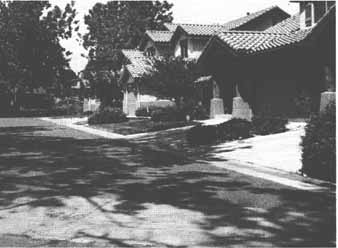
Shade trees cool homes by blocking sunlight and through
evaporative cooling.
Carefully placed shade trees can block sunlight striking the house. They can also be used to shade heat- absorbing streets, sidewalks, driveways, patios, and other sun-absorbing, heat-producing surfaces, even sheds and nearby vacant lots. If you want shade now, however, plant fast-growing trees, Also, buy the largest trees you can afford. Don’t plant tiny seedlings to save a few bucks. Young trees are more likely to perish, and take many years to reach full size. You may be in the retirement home — or in the nearby cemetery — before they begin producing significant shade, Bite the bullet and purchase large trees or, at the very least, fast-growing trees like cottonless cottonwoods. (Consult your local nursery for advice on the hardiest, fastest-growing shade trees,).
I recommend planting deciduous as well as non-deciduous trees (evergreens) on the north, west, and east sides of home to provide shade. If you are going to retrofit your home for passive solar to provide space heat, keep the south side tree-free, If you want to plant trees on the south side, be sure to minimize the number and then plant only high-crowned deciduous trees; they’ll lose their leaves in the fall which will still allow some solar gain. (Consult with a local nursery on the best type of tree.) Whatever you do, don’t plant evergreen trees on the south side of your home (___ below). Evergreens dramatically reduce, even eliminate, the potential for passive solar gain.
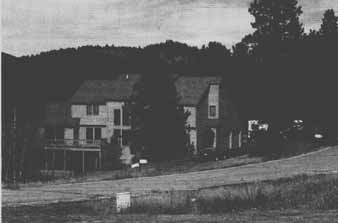
Evergreens on the south side of homes block the low-angled
winter sun and dramatically reduce, even eliminate, potential passive
solar gain.
If you are planning on adding a solar hot-water system or solar electric system, be certain that the roof is unshaded year-round. As you will learn in the next section, even a small amount of shade on most solar arrays will dramatically reduce electrical production.
If the roof is shaded, you can still install a solar hot water system or a solar electric system but you’ll need to have access to a sunny space near your home, for example, the roof of your garage or a section of your lawn where you can mount solar panels on a pole, tracking device, or rack (see next Section). They need to be shade-free year-round, too, for optimal production.
Reducing External Heat Gain by Shade Structures
Shade can also be provided by structures such as an arbor. As shown in below, an arbor is a wooden frame for growing grapes, ivy, or other forms of vegetation (even squash and cucumbers) in the spring and summer. The vegetation provides edible fruit, lovely flowers, and habitat for birds and butterflies, but also intercepts the sun, creating delightful shade. Shade provided by an arbor reduces heat gain through the windows and walls of a home. The vegetation adorning an arbor, however, also cools the air around a home (via evaporation), reducing external heat gain. Arbors create lovely spots for you to relax on a hot summer day, too.
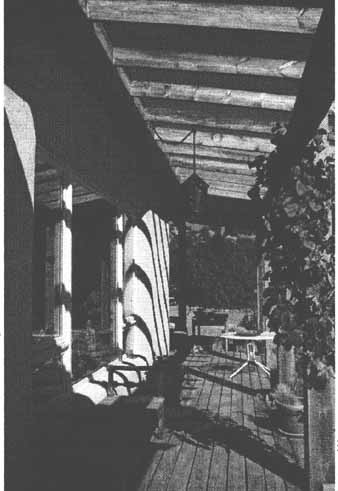
Vine-draped arbors such as this provide many benefits and are a great passive cooling measure.
Vines can also be grown on trellises or directly on the exterior walls of a home. Ivy adds a touch of beauty to a home, and also shades the walls and provides evaporative cooling.
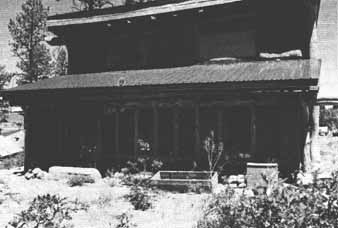
Overhangs protect windows and wails from the high and intermediate summer sun.
Appropriate overhangs also reduce external heat gain (___ above). Unfortunately, many homes in North America were built without overhangs to save money. It’s even offered as a suggestion to cut costs today, for example, in Building an Affordable House by Fernando Ruiz. and some designs, for example, traditional southwestern-style homes, come without overhangs.
Although it is possible to retrofit a home that lacks sufficient overhangs, it is not easy, nor is it cheap. It may also detract from its aesthetics. Don’t despair, though; there are ways to compensate for the builder’s cost-saving measure, for example, awnings and external shades. We’ll examine these options in the next section,
Reducing External Heat Gain via Mechanical Shading Devices
One way to provide shade to walls is by installing awnings like those shown in ___ below. Properly installed awnings can reduce heat gain through windows by as much as 65 percent on south-facing walls and 77 percent on east-facing walls, Select light-colored awnings to reduce heat buildup around the house.
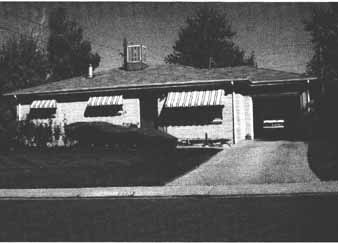
Awnings can dramatically reduce heat gain through windows
in the summer.
Awnings may be fixed or retractable, I recommend retractable acrylic awnings when ever possible, especially on the south side of a home, to ensure maximum solar gain in the winter. You may even want to consider motor-driven awnings with wind sensors that retract in high winds to prevent damage. For more information on retractable awnings visit this site. This web site contains 3-D rendering software that allows you to enter a picture of your home so that you can see what different retractable awnings will look like before you lay your money down.
Window shades also help to reduce external heat gain. Window shades come in a variety of forms and are especially useful on west-facing windows during the summer as the sun makes its long, slow descent. Window shades are also useful on the hot days of spring and especially the fall, times when heat is not required, yet the sun is beginning to descend in the sky. It’s at such times that the sun is beginning to provide a little unwanted solar heat.
For best year-round performance in colder regions, you should give strong consideration to insulated window shades, for example, cellular shades made from quilted fabrics or, best of all, shades made from Warm Window material. (Warm Window fabric comes with two layers of insulation to reduce heat flow and a layer of silver Mylar to reflect heat.) Insulated window shades will help to keep the sun out during the late summer, and will help hold heat in your home in the winter.
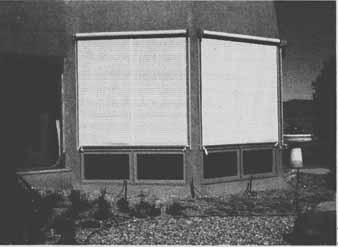
Window shades on the outside are more effective than
internal shades when it comes to reducing external heat gain.
Window shades may be installed inside or outside (___ above). In the vast majority of homes, window shades are installed inside for practical reasons: they are accessible, easy to operate, and protected from the weather, But while most window shading devices are internal, external shades are preferable.
Why?
Unless shades are coated with a reflective material, internal shades still allow considerable amounts of sunlight to penetrate windows. Sunlight is then converted into heat that leaks into rooms.
External shades, on the other hand, block or nearly completely block sun from entering homes, greatly reducing external heat gain. Don’t worry about having to live in a dark cave; shades can be drawn only when sunlight penetration is greatest, for example, in the late afternoon, As you will soon see, some types of external window shades permit some light to enter your home.
In recent years, manufacturers have devised some rather innovative internal and external window shades to which you should also give strong consideration. One is the solar screen. Solar screens consist of a fine mesh that blocks sun much like the solar screen used in greenhouses. They’re installed in frames that are usually mounted in window frames from the outside.
Another is the solar shade, a tinted acrylic shade typically installed inside homes. Although the solar shade blocks sunlight, it is also clear enough that one can see outside. Another ingenious invention is cellular shades that rise from the bottom up. They can be used to block the sun penetrating the lower parts of windows in late spring and early fall.
Reducing External Heat Gain by Upgrading Insulation, Sealing Cracks, and Replacing Windows
Insulation in ceilings, walls, and around foundations also helps to thwart external heat gain. Because we listed many options for upgrading insulation in this Section on passive solar heating, we’ll simply refer you to that section now, if you haven already read it.
Suffice it to say that any step taken to improve the heat resistance of the building envelope will help keep the home warmer in the winter and cooler in the summer. Because of this, insulation is one of our greatest allies in reducing external heat gain. The same can be said for efforts that make our homes more airtight. Sealing up cracks and various openings goes a long way toward making a house more comfortable all year long. It’s one of the least expensive, easiest, and most profitable steps you can take to make your home cooler in the summer and warmer in the winter.
Yet another dual-function measure — that is, a measure that helps make a home warmer in the winter and cooler in the summer — is window replacement. Replacing old, leaky, and energy-inefficient windows with modem, airtight, energy-efficient models can make a world of difference. As noted in a publication on home energy efficiency published by the US Department of Energy, about 40 percent of summertime external heat gain enters a home through its windows, If you want to save energy and achieve a greater level of energy independence, low-e windows are a must! Even if you can’t afford to replace your windows, other upgrades, such as those discussed earlier, can go a long way toward eliminating external heat gain and making your summers much more comfortable.
FYI: Insulation is one of our greatest allies in reducing external heat gain. The same can be said for efforts that make our homes more airtight.
Reducing External Gain by Repainting Your Home
Several studies over the past 20 years have shown that light-colored paints dramatically reduce heat gain in urban homes. Combined with other measures, like improving shade, upgrading insulation, and sealing a house against leaks, light-colored paints can dramatically reduce a family’s cooling needs.
Light-colored walls help reduce heat gain because they reflect more sunlight off a home than darker colored walls, Lighter siding also lasts longer and saves you money, too. Combined with other measures, light-colored walls can take a significant chunk out of your annual fuel bill. One study in a residential neighborhood in Phoenix, Arizona, for example, showed that three trees planted near light-colored houses could cut cooling costs by 18 percent per year. In Sacramento and Los Angeles, the savings were even greater: 34 and 44 percent, respectively.
Certain colors and types of roof shingles can also reduce external heat gain. If your home is in need of re-roofing, consider lighter-colored shingles, metal roofing, or Spanish tile, if they fit in with your home design and color schemes. Lighter-colored shingles reflect more sunlight back into the atmosphere, reducing heat gain through ceilings. Metal, roofing tends to be installed in ways that creates a small airspace between the roofing material and the decking that retards heat gain. Spanish tiles create even larger airspaces that reduce heat absorption.
Reducing Heat Gain by Installing Radiant Barriers
Radiant barriers are relatively new products that are becoming more and more popular each year in new construction as well as in homes being retrofitted for energy efficiency, especially in hot climates like that of the southeastern United States (___ below). Radiant barriers are durable aluminum foils (with a sturdy backing material) that are stapled to roof rafters or attached to roof decking. Radiant barriers block heat from entering the attic. According to the Florida Solar Energy Center, a radiant barrier can cut cooling costs by 8 to 12 percent per year in hot climates like Florida’s, This small but significant reduction, when combined with other measures described in this section, can nudge your home much closer to energy independence and cheap, low-impact comfort.
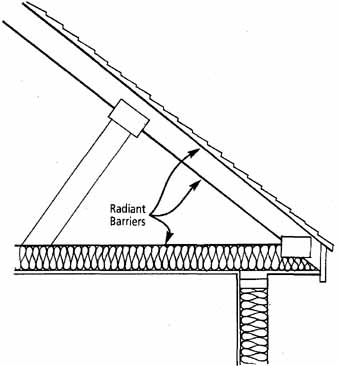
Radiant barriers help reduce external heat gain through
roofs and are becoming much more popular in modern construction. This
drawing shows three locations in which radiant barrier are installed.
Purging Heat
In our house, we’ve succeeded in eliminating enough external and internal heat gain that we’re 100 percent passively cooled. Much to the dismay of the tax assessor’s office, I have no cooling system, yet stay cool all summer long, even when outside temperatures are in the mid to high 90s, In most existing homes, built with less exacting energy standards, it is nearly impossible to achieve this goal. No matter how hard you try to eliminate internal and external heat sources in your home, you will still be left with some heat. It must be eliminated to achieve optimum comfort.
Getting rid of that heat is the third line of attack in achieving passive cooling. What you do to address this problem depends on the climate in which you live.
Purging Heat via Natural Ventilation
In temperate climates, heat can be purged naturally by establishing some good old-fashioned cross ventilation — that is, by allowing air to flow through your home during the day. For this strategy to work, you must have a cool air reservoir, That is, you must have a cooler area, for example, a well-shaded back yard on the north side of the home, from which you draw cool air into your home. Cool air entering through windows on the north side flows naturally through a house, purging heat. It then exits through windows on the warmer side, for example, the south, east, or west sides, on the same level.
Air can also be encouraged to flow vertically from windows on lower levels to windows in upper stories, Creating air flow from lower to upper levels occurs because of a phenomenon known as the stack (or chimney) effect, This results from a phenomenon we all familiar with: hot air rises. When hot air in a home rises, it draws cooler air in through open windows on lower levels. If those windows open to much cooler outdoor air, you should be in for a treat. Natural convection currents should naturally purge heat from your home, helping to maintain internal comfort.
The natural flow of cool air through a home performs a second function as well: it helps to cool people down much like a fan blowing air across your face. (I’ll discuss this in a moment.) Natural cross-ventilation and the stack effect produce a soothing flow of cool air that removes heat from your home. To enhance the effect, you may want to draw outside air into your home through your basement, provided the basement is not too musty smelling.
Why?
Basements tend to stay cool in the summer. If funneled through a cool basement, outside air can be cooled even more. Outside air, cooled by the basement, then flows up through the stairwell into the first level — and even into the second level of two-story homes — where it exits via a few open windows.
Natural ventilation works in virtually all climates early and late in the cooling season. There’s generally no need to run air conditioners during this time, In some climates, though, natural ventilation can work throughout most, if not all, of the cooling season, especially if you have insulated your home well, planted trees, for shade, painted your home a light color, sealed cracks, and pursued other measures described in this section to reduce your cooling load. Hot, arid climates are one such place where passive cooling works well.
Nighttime Heat Purging
In desert climates, daytime cross ventilation strategies work well early and late in the cooling season. For most of the rest of the summer and fall, however, daytime temperatures are too high for this strategy to work. Natural ventilation must occur during the night.
Why?
In deserts, air cools dramatically at night because of the lack of moisture in the atmosphere. (Moisture in the atmosphere is a greenhouse gas, retaining heat like a huge blanket over such areas.) Thus, even though temperatures may climb to 105°F (40°C) or more during the day, evening temperatures in the desert typically fall into the 50s and 60s (10° - 15°C). The sudden and significant drop in evening temperature provides conditions optimal for nighttime heat purging. Opening a few windows to encourage cross ventilation, or to promote the stack effect in two-story homes, allows cool air to circulate through a home, The cool nighttime air scours he-at that has accumulated inside the structure from internal and external sources. By morning the home is cool as a cucumber and ready to repeat the cycle once again.
Homes that contain significant amounts of thermal mass, such as tile floors or adobe walls, work even better. That’s because these forms of thermal mass absorb heat during the day, helping to maintain cooler interior temperatures.
At night, cool outside air flowing through the house strips the heat from the mass, rejuvenating it for another day’s cooling cycle. Not only are cool evenings in desert climates ideal for passive cooling, they’re amazingly comfortable for sleeping. Unless you’re in a highly developed area with so many homes that evening breezes are thwarted and so much heat-absorbing pavement that it takes a long time to cool down, nighttime purging, when combined with all of the other measures I’ve been discussing, could provide your ticket to energy independence.
A Little Active Boost
In some areas, you may have to rely on some active measures to provide a little boost to passive cooling measures and achieve comfort levels you and your family find desirable. Three of the least expensive and most effective measures are window fans, attic fans, and whole-house fans. Box fans mounted in windows can dramatically increase air circulation; they’re an inexpensive and simple way to boost natural ventilation.
Attic fans are usually mounted on the roof, like the solar attic fan in ___ below. Attic fans typically operate during the day to purge heat that seeps in from the roof. Purging heat with a fan reduces heat buildup in attics and thus reduces the amount of heat that enters our homes through ceilings.
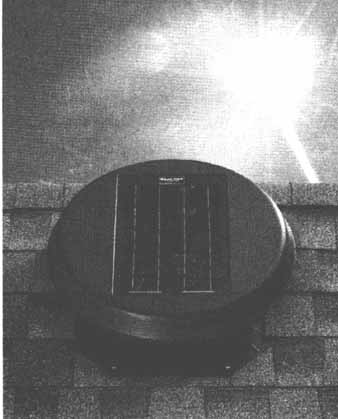
Solar attic fans purge heat from attics, reducing external
heat gain through ceilings.
Whole-house fans mount in the ceilings, usually in a central location (see ___ below). They draw air in through open windows, then vent it out through the attic. (Openings in the gable ends of homes allow air to escape from the attic.)
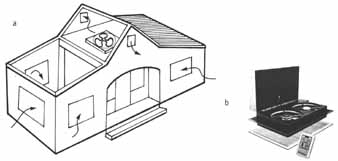
Whole-house fans create cross ventilation and also purge
heat from attics.
Whole-house fans not only help to cool attics to reduce external heat gain, they also cool the interior of homes by drawing cool air into the structure.
“Whole-house fans are ideal for homes in climates that don’t require air conditioning. However, they are also a perfect solution for homeowners who wish to run their air conditioning less often,” says the vice-president of marketing for Air Vent, Inc., a company that manufactures amazingly quiet whole-house fans. Some homeowners use whole-house fans early and late in the cooling season — or early and late in the day — when daytime temperatures are below the temperature inside their homes; others use them at night to encourage nighttime purging. This strategy, however, won work if outside temperatures remain high during the evening, as in hot, humid climates like those in Georgia and Louisiana.
Whole-house fans can be noisy and clunky looking; they appear rather industrial, Responding to this criticism, Air Vent, Inc. created Whisper Aire, a sleek, attractive model, shown in ___ b. Homeowners said they liked the benefits of whole-house fans (energy efficiency, fresh air), but that they were too difficult for the average do-it-yourselfer to install. To simplify the installation process, the unit is designed so that it can be located between ceiling joists spaced at either 16 or 24 inches on-center, which means the fan will fit between the joists without having to cut and reinforce ceiling joists, which is difficult and time-consuming. Because it’s smaller and lighter than traditional whole-house fans, it’s easier to handle during installation too.
Another advantage of the Whisper Aire whole-house fan is its insulated automatic shutter. Providing an R-value of 25, the shutter minimizes the heat transfer between attic and living spaces. Whisper Aire is operated via remote control. This eliminates the need to drop wires down an interior wall to a switch, which makes this model even less complicated for the typical homeowner to install. The remote has five speeds and four timer settings that can be set to circulate for one-half, two, four or six hours.
Air Conditioners and Evaporative Coolers
Heat can also be purged at night — or on days when passive cooling measures can’t keep up with internal and external heat gains — by air conditioners or, in arid climates, evaporative coolers (once commonly referred to as swamp coolers).
If your home is equipped with an air conditioner or evaporative cooler, you should notice a dramatic decline in usage and electrical bills after implementing the suggestions in this section. Don rest on your laurels. There are additional ways to cut the use of these devices, for example, by improving their operating efficiency. For central air conditioners, you can begin by replacing dirty filters.
This simple, cost-effective step will make the units work more efficiently and cut energy bills. If your air conditioner is located in a sunny location, find a way to shade it. Air conditioners work a lot more efficiently if they’re not baking in the hot sun all day long. Even an artificial shade structure over an air conditioner will help it function more efficiently — and will cut down on energy use. Next, be sure that the air ducts that distribute cool air in your central air conditioning system are well sealed. Poorly sealed ducts can leak a considerable amount of cool air into unconditioned spaces, for example, attics. Leaks of this nature can easily waste a quarter of the energy your air conditioner uses to keep your home cool. Leaks dramatically increase run time and overall energy use.
To seal ducts, use mastic. It is a gooey, long-lasting adhesive that’s painted on with a paint brush. Do not use duct tape or aluminized duct tape. Mastic will last much longer than either of these products. You may also want to insulate cooling ducts that run through unconditioned space. Most local hardware stores carry a couple of different products for insulating large ducts.
Finally, you may also want to call your local utility company or contact a local air conditioning specialist to take a look at your air conditioner to make sure that it is running efficiently.
If you need to replace your air conditioner, purchase a super-energy-efficient model. Don’t call around to local suppliers or installers, though. Look first online or in the Consumer Guide to Home Energy Savings. It lists the most efficient air conditioners on the market today, and should help you select a model that will work for you. On a related issue, be sure that whoever sells and installs your new air conditioner doesn’t oversize it. Be certain they know all you have done to reduce the cooling load in your home. Give the installer a list of your energy upgrades so he or she can size the system correctly. The energy efficiency improvements you made should reduce the size of the air conditioner, easily paying off most, if not all, of the costs of your upgrade.
Alternatively, you may want to consider installing an energy-efficient heat pump “air conditioner”. One common type used largely in warmer or moderate climates like that of the southern United States is the air-source heat pump, discussed in this section. Air-source heat pumps suck heat out of our homes in the summer and release it into the outside environment. They are generally much more energy-efficient than air conditioners. In fact, they are used in a lot of new homes right now.
Earlier we noted heat pumps can also be used for wintertime heating. During the winter, a heat pump extracts heat from the outside air. Using refrigeration technology, the heat pump concentrates the heat and then transfers it into the home.
FYI: Size Matters -- Contrary to common belief, an oversized air conditioner is extremely inefficient. It cycles on and off very frequently, which is inherently inefficient, and in so doing, doesn’t effectively dehumidify the air, either.
Evaporative coolers are also widely used in many areas, notably hot dry regions, to cool homes, stores, restaurants, shops, and other buildings. Evaporative coolers draw dry outside air through a wet porous mat, kept moist by water dripping down from the top of the mat. Dry air passing through the mat evaporates the moisture and is therefore cooled. (Remember, evaporation sucks heat out of air.) The cooled air is then blown into the building, providing economical comfort on the hottest of days. Evaporative coolers use much less energy than air conditioners, but as noted above are only appropriate in dry climates. Be sure to select a more water-efficient design.
Cooling Humans
The fourth tool in the passive cooling toolbox falls under the category of cooling people directly. One of the most economical ways to cool people off is the fan. Any fan will do as long as it creates air movement that strips heat from our bodies. You can test this idea by fanning your face with a piece of paper.
You feel immediately cooler without lowering the air temperature. Why does this make you feel cooler? Heat tends to accumulate in a zone immediately surrounding our bodies called the boundary layer. Pushing that warm air aside immediately makes a person feel cooler.
How much?
Operating a ceiling fan has the same effect as lowering room temperature by 4°F (2°C), and ceiling fans use much less energy than air conditioners or evaporative coolers! Fans can be used in any climate in conjunction with air conditioners or evaporative coolers. They are especially useful in hot, muggy climates. Using a ceiling fan in conjunction with an air conditioner allows us to raise thermostat temperature settings, saving considerable amounts of energy. in fact, each degree of increase in your thermostat setting cuts cooling costs by about eight percent, according to the authors of the Consumer Guide to Solar Energy.
The Trickiest Climates
Passive cooling is a pretty straightforward process that requires incremental application of many small, seemingly inconsequential measures, that collectively make huge dents in our cooling bill (see Tables “REDUCING INTERNAL HEAT GAIN ” above, and “STEPS TO PASSIVE COOLLING” ). The hardest of all climates to cool in, though, are those with hot, humid weather. In such areas, hot, humid days turn into hot, humid nights.
Heat trying to escape from the Earth’s surface in a hot, humid climate can’t — it is trapped by atmospheric moisture.
In hot humid regions, the passive cooling measures outlined in this section often work well early and late in the cooling season when combined with natural ventilation (to purge heat from homes) and fans (to cool people).
During the hottest days of the year, however, passive cooling measures will very likely require a little assistance from a ceiling fan or two and perhaps even an air conditioner. If interior daytime temperatures are sufficiently comfortable, an air conditioner can be used to purge heat at night. If that doesn’t work, you’ll need to run the air conditioner during the day, but run time should be dramatically reduced.
Next: Creating a Sustainable Future
Prev: What is Passive Cooling?